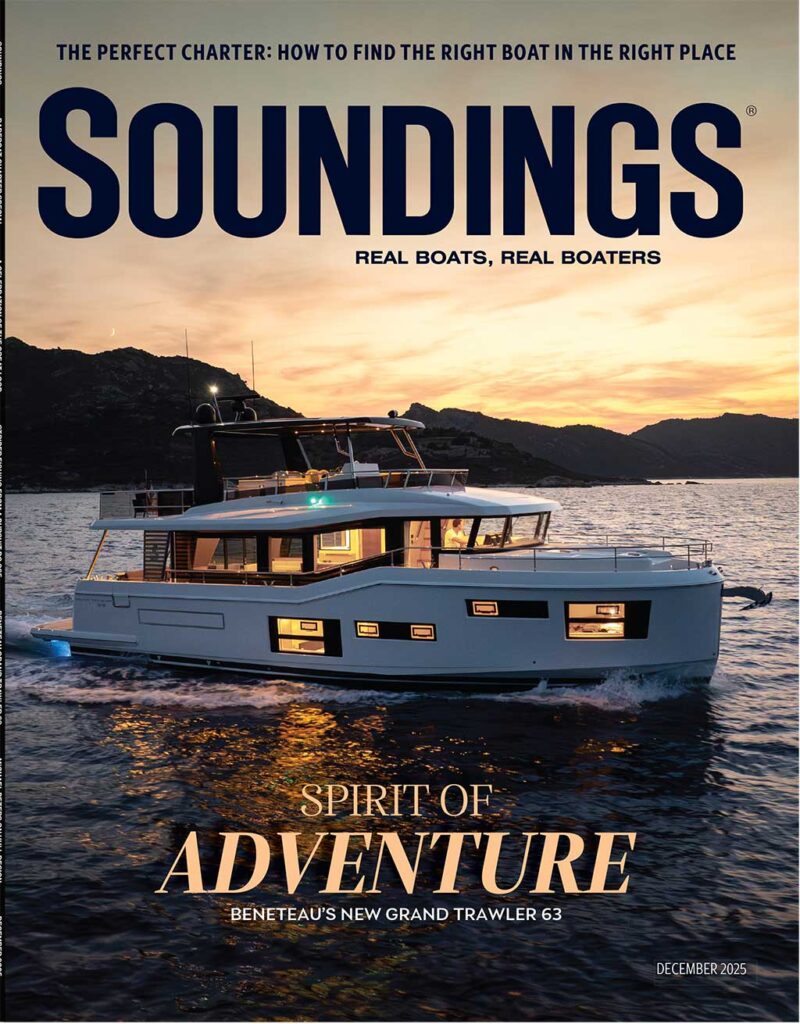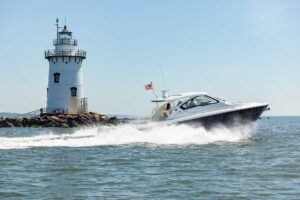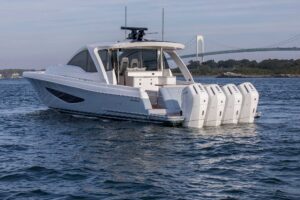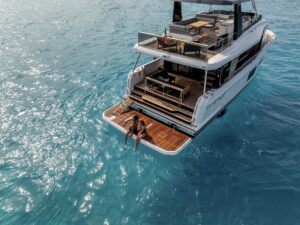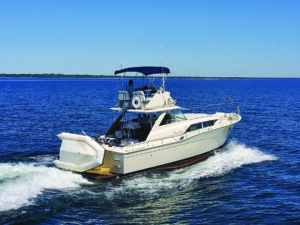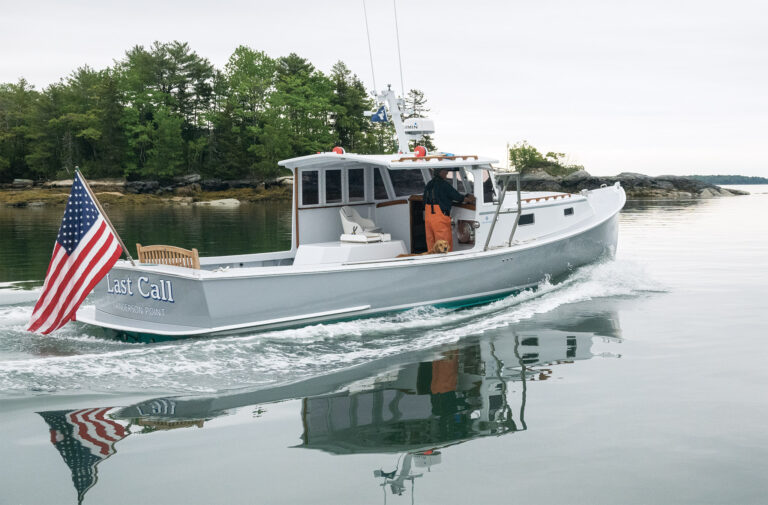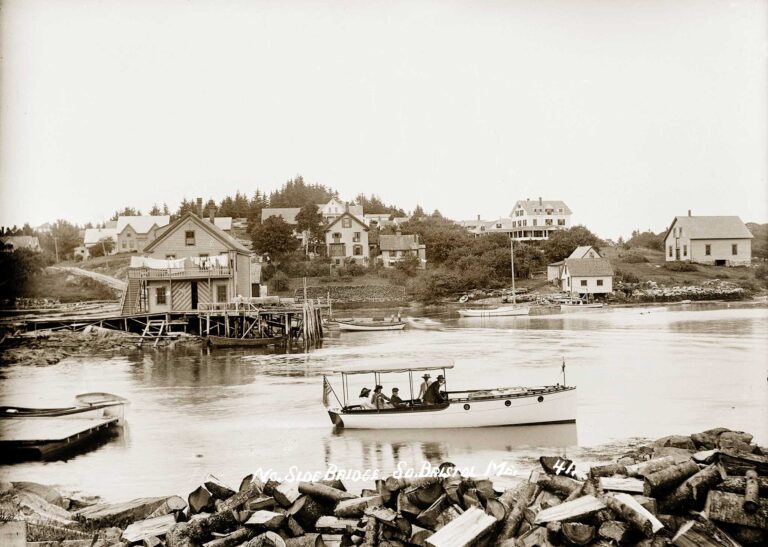To get a better take on some of the issues Bill Johnson raised when I interviewed him, I called Chris Murray, director of sales for Soundown, a company well known in the marine industry for its noise and vibration control products. He added some interesting insights on how to solve noise and vibration problems.

“One thing we sometimes find is that the original components could be improved on, so we offer better engine mounts, mufflers and sound-deadening materials than might have come with the boat,” Murray says. “Some of our diagnostic efforts take specialized equipment and expertise to carry out, but you don’t need to be an expert to know you have a vibration or sound-level problem. An owner can feel vibrations or hear excessive noise and have a good idea where it’s coming from. For example, you can hear a 200-hertz buzz and know that’s often related to excessive prop-tip speed or a prop-tip clearance issue.”
When the company’s experts delve into the causes of a noise and vibration problem, they always ask what the owner hears and feels when the boat is under way. They turn that information into a series of solutions, some of which might involve one or more of Soundown’s products.
Murray says 90 percent of the noise and vibration problems in boats to 60 feet are related to the engine, the prop and/or the exhaust system. Depending on the propeller shaft rpm, one of these common causes of noise and vibration will predominate while the boat is traveling between 20 and 25 knots, but at higher speeds wind- and water-generated noise start to predominate.
“Our goal is to reduce the engine, prop and exhaust noise levels to the approximate range of the wind and water noise,” Murray says. “A typical lobster yacht running at 20 knots will have wind and water noise at 85 to 87 dBA [decibels] and we work to get drivetrain noise levels below this point. Even on a 50-footer you can’t get much more than 15 or 20 feet away from a pair of screaming diesels, so we’ve done our job if the drivetrain is quieter than ambient noise at the boat’s cruise speed.”
There are two types of noise to deal with: airborne and structure-borne. Airborne noise escapes and propagates through leaks and gaps, and to reduce it Soundown has barrier materials such as special backing pads to install under carpeting and mass-loaded plastic sheets. Structure-borne noise is driven by vibration. It can result from hull stringers, deck support stanchions or even hard-mounted exhaust lines transmitting vibrations through the boat. Solutions include installing better engine mounts and mounting stanchions, decks and bulkheads on vibration-absorbing foam mounts. A soft coupler can be installed between the transmission and the propeller shaft to minimize engine vibrations.
Interrupting the path through which vibrations and noise travel is key. For example, the Navy destroyers and cruisers on which I served pumped a layer of air bubbles through a series of transverse steel belts running across the bottom of the hull that were full of pressurized air and had thousands of tiny holes drilled in them to block machinery noise. The belts made the ships much quieter, which would have been important if an enemy submarine happened to be lurking nearby. This is also why soft engine mounts attached to much harder and more massive engine beds are used on pleasure boats – it interrupts the path noise and vibrations can take.
Engine noise leaks
Along these same lines, if air can get through a deck or bulkhead, noise can, too. Noise comes through air gaps even if the deck is well insulated. Soundown’s strategy is to seal out the air, which seals the noise paths as well. These problems sometimes have simple fixes. “With $50 worth of gasketing materials, you might be able to drop noise levels by 3 or 4 dBA,” Murray says, pointing out that every 10 dBA reduction halves the noise levels, which are measured on a logarithmic scale.
Another solution that might work, Murray says, is to install a quality sound-absorbing backing pad under the carpet. Such a pad can reduce noise levels by 3 to 7 dBA, depending on the boat. This can also be a much more efficient way of reducing noise, since trying to line the underside of the deck and the engine room overhead with sound-deadening material can be very difficult with all the irregular surfaces and openings. A one-piece sound blanket is a much easier and often more effective solution.
Soundown’s basic carpet backing pad weighs 1 pound per square foot and its premium material weighs 2 pounds per square foot. The whole trick to sound reduction is adding mass and distance between the noise source and the cabin. Murray says the backing pad option for a 12-by-12-foot saloon in a typical 40-footer would run around $450 and it would typically drop engine-radiated noise levels by 3 to 7 dBA, as previously noted.
The materials used in Soundown’s products are measured according to their weight per square foot. A pound of material in a square foot can come in the form of lead 1/32 of an inch thick, or in the form of 1/8-inch-thick mass-loaded plastic. If you haven’t heard of mass-loaded plastic, here’s a brief explanation: Plastic in crumb powder form is mixed with denser powdered barium sulfate and limestone during the manufacturing process, driving up the weight of the material and creating a sound-absorbing matrix. Heavier material has better sound-blocking qualities than lighter material. Whether you have a pound of steel, lead or red cedar per square foot, the impact on sound reduction is the same, although the denser the material, the less space/volume it takes up.
Within a foam-backed sound-absorbing material with two layers or a single sheet of mass-loaded plastic, the more distance there is between the layers (the more decoupling), the lower the sound frequencies that will be absorbed. The reason for this is that lower sound frequencies have commensurately longer wavelengths that are absorbed by the greater separation distance between the two layers. The same goes with the distance between the mass-loaded plastic and the substrate (the deck). Since a diesel generates noise at a variety of frequencies – high-frequency turbocharger whine, low-frequency exhaust noise – a mix of materials and decoupler distances is often the best solution. While isolating the sound from the saloon or cabin is important, if the sound reverberates around as in an echo chamber, magnifying noise levels, then you may want to consider installing softer interior bulkhead and overhead treatments.

Engine beds and mounts
While the problem may seem to be the engine mounts, the real issue may be the engine bed, Murray says. On most boats, the engine beds are the hull stringers passing from bow to stern. In a fiberglass boat, these might be wood encapsulated in fiberglass or high-hat, hollow fiberglass stringers glassed or bonded to the hull.
While a planing boat needs to be light enough for efficient propulsion, the stringers (engine beds) inside the engine room should have enough mass to absorb vibrations passed on through the mounts. If wood-cored, the engine beds may need to be increased in mass (height and width). With hollow fiberglass stringers, the sections where they serve as engine beds should be solid – filled with wood, usually – instead of being hollow or just filled with foam.
“The engine bed needs to be 10 times stiffer than the mounts in terms of mobility for a good working combination,” says Murray.
Propeller noise
For propeller noise, the simplest solution may be to add sound-dampening tiles inside the hull above the props. This is just another way to add the mass that is needed to absorb vibrations and reduce noise. “We also have very clear guidelines for a 20-percent prop-tip clearance and following this standard alone makes many prop noise problems go away,” Murray says.
Propeller-tip speed is also an important factor in controlling noise. “We look for a maximum of 150 feet per second [rpm multiplied by propeller radius] at cruise speed, but we prefer to see it closer to 120 feet per second since you don’t often have issues at these slower tip speeds.”
Another solution can be to go from a three- to a four-blade prop, which increases the frequency by 33 percent, Murray says, adding that this option can make it easier for Soundown to address the situation and that it may even be enough to eliminate the problem. Prop noise comes from the rotational energy and then there are hydrodynamic noises from water flow against the hull. A cored fiberglass hull, or one that has foam-filled hull cavities for positive flotation, will also be quieter than a solid hull.
Exhaust systems
The muffler is another common noise source. “The muffler used by the builder is likely to be a standard one-size-fits-all pot-style [vertical] unit – say a 6-inch model for a V-6 diesel that’s selected solely on how much air and water pass though the exhaust system each minute. We select mufflers based on the engine’s firing rate and number of cylinders, and use either water-drop vertical or horizontal mufflers to suit the application,” Murray says.
“Most exhaust systems are 90 to 95 dBA measured at the transom, but if the system is engineered correctly, we can get exhaust noise levels down to that of the prop wash, which is typically around 80 dBA. For a 35- or 40-footer with 350-hp diesels, we might replace the existing mufflers with a pair of $1,500 [each] mufflers that are matched to the engines,” he says.
New mufflers for 500-hp diesels would cost around $2,000 each. Installation costs will vary depending on the boat, especially in terms of the accessibility of the lazarette or engine room.
“We often see noise reductions on the order of 40 to 50 percent at cruise rpm with this approach,” Murray says. For the ultimate in quiet, systems that discharge exhaust underwater from these mufflers are available.
Summary
One thing many owners don’t consider is that the Occupational Safety and Health Administration has standards for exposure to noise. For example, you should wear hearing protection if you are exposed to 85 dBA or more for eight hours a day. Hearing loss and fatigue are the results of excessive noise, with eardrum damage being potentially irreversible. If noise levels are at 88 or 90 dBA – not uncommon with many diesels today, even up on the bridge – then the exposure time is even less. You really don’t want to be on a boat with noise levels this high. In addition to the physical damage of permanent hearing loss, there’s the impact on enjoyment to consider.
“You have to ask yourself how enjoyable is it to be out on a boat that is this loud,” says Murray. “You can hardly hear yourself think, let alone talk to your friends or family standing right next to you. It’s like standing around a machine shop with a drink and a snack or a rod in your hand and trying to carry on a conversation.”
Soundown’s website, www.soundown.com, is a good source for information on the subject. Have a look at the company’s “Handbook of Noise Control Materials” and the suggestions section of the website.
I’d recommend buying a $60 Radio Shack sound level meter, which is what I use on boat evaluations. Use the A-weighted scale that approximates the human ear and the slow response mode shaves off the peaks so you have usable information to go with. If the noise levels in the cabin, pilothouse or cockpit are above 85 dBA at cruise speed, I’d have something done about it.
I have been on exceptionally quiet boats, like a Riviera 4700 or Alden 50. With a pair of 800-hp Cats roaring away two feet below the deck, I recorded 74 dBA at the lower helm station. It makes for a far more pleasurable cruise to be able to carry on a conversation with someone sitting 10 feet away without raising your voice.
Loud noises fatigue the ears and the mind and a tired boat operator isn’t good for obvious reasons. Risk of mishap goes up with fatigue and, in any event, these are called pleasure boats for a reason, so it makes no sense to put yourself through that.
See related story:
– Good – or not-so-good – vibrations
This article originally appeared in the December 2010 issue.

